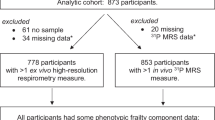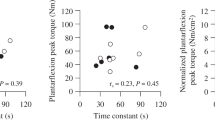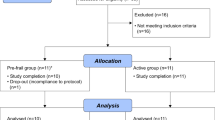Abstract
Background
Physical frailty is a clinical syndrome associated with aging and manifesting as slowness, weakness, reduced physical activity, weight loss, and/or exhaustion. Frail older adults often report that their major problem is “low energy”, and there is indirect evidence to support the hypothesis that frailty is a syndrome of dysregulated energetics. We hypothesized that altered cellular energy production underlies compromised response to stressors in the frail.
Methods
We conducted a pilot study to assess muscle energetics in response to a mild isometric exercise challenge in women (n=30) ages 84–93 years. The frailty status was assessed by a validated physical frailty instrument. Localized phosphorus (P31) magnetic resonance spectroscopy with a 1.5T magnet was used to assess the kinetics of Phosphocreatine recovery in the tibialis anterior muscle following maximal isometric contraction for 30 seconds.
Results
Phosphocreatine recovery following exertion, age-adjusted, was slowest in the frail group (mean=189 sec; 95%CI: 150,228) compared to pre-frail (mean=152 sec; 95%CI: 107,197) and nonfrail subjects (mean=132 sec; 95%CI: 40,224). The pre-frail and frail groups had 20 sec (95%CI: −49,89) and 57 sec (95%CI: −31,147) slower phosphocreatine recovery, respectively, than the non-frail. This response was paralleled by dysregulation in glucose recovery in response to oral glucose tolerance test in women from the same study population.
Conclusions
Impaired muscle energetics and energy metabolism might be implicated in the physical frailty syndrome.



Similar content being viewed by others
References
Fried LP, Tangen CM, Walston J, et al. Frailty in older adults: evidence for a phenotype. J Gerontol A Biol Sci Med Sci. 2001;56(3):M146–156.
Bandeen-Roche K, Xue QL, Ferrucci L, et al. Phenotype of frailty: characterization in the women’s health and aging studies. J Gerontol A Biol Sci Med Sci. 2006;61(3):262–266.
Morley JE, Vellas B, Abellan van Kan G, et al. Frailty consensus: a call to action. J Am Med Dir Assoc. 2013;14(6):392–397.
Fried LP, Xue QL, Cappola AR, et al. Nonlinear multisystem physiological dysregulation associated with frailty in older women: implications for etiology and treatment. J Gerontol A Biol Sci Med Sci. 2009;64(10):1049–1057.
Fried LP, Hadley EC, Walston JD, et al. From bedside to bench: research agenda for frailty. Sci Aging Knowledge Environ. 2005(31):pe24.
Fried LP. Conference on the physiologic basis of frailty. Aging Clin Exp Res 1992; 4: 251–265.
Ashar F, Moes A, Moore A, et al. Association of mitochondrial DNA levels with frailty and all-cause mortality. J Mol Med (Berl). 2015;93(2):177–186.
Bortz WM. Frailty. Mech Ageing Dev. 2008;129(11):680.
Kalyani R, Varadhan R, Weiss CO, Fried LP, Cappola AR. Frailty status and altered dynamics of circulating energy metabolism hormones after oral glucose in older women. J Nutr Health Aging 2012;16(8):679–686.
Kalyani RR, Varadhan R, Weiss CO, Fried LP, Cappola AR. Frailty status and altered glucose-insulin dynamics. J Gerontol A Biol Sci Med Sci. 2012;67(12):1300–1306.
Weiss CO, Cappola AR, Varadhan R, Fried LP. Resting metabolic rate in old-old women with and without frailty: variability and estimation of energy requirements. J Am Geriatr Soc. 2012;60(9):1695–1700.
Buchner DM, Wagner EH. Preventing frail health. Clin Geriatr Med. 1992;8(1):1–17.
Lipsitz LA. Dynamics of Stability: The Physiologic Basis of Functional Health and Frailty. J Gerontol A Biol Sci Med Sci. 2002;57(3):B115–125.
Moore AZ, Biggs ML, Mateini A, et al. Polymorphisms in the Mitochondrial DNA Control Region and Frailty in Older Adults. PLoS One. 2010;5(6):e11069.
Short KR, Bigelow ML, Kahl J, et al. Decline in skeletal muscle mitochondrial function with aging in humans. Proc Natl Acad Sci USA. 2005;102(15):5618–5623.
Varadhan R, Seplaki CS, Xue QL, Bandeen-Roche K, Fried LP. Stimulus-response paradigm for characterizing the loss of resilience in homeostatic regulation associated with frailty. Mech Ageing Dev. 2008;129(11):666–670.
Kitano H. Biological robustness. Nat Rev Genet 2004;5(11):826–837.
Stelling J. Mathematical models in microbial systems biology. Curr Opin Microbiol. 2004;7(5):513–518.
Kitano H, Oda K, Kimura T, et al. Metabolic Syndrome and Robustness Tradeoffs. Diabetes. 2004;53 Suppl 3:S6–S15.
Varadhan R, Walston J, Cappola AR, Carlson MC, Wand GS, Fried LP. Higher Levels and Blunted Diurnal Variation of Cortisol in Frail Older Women. J Gerontol A Biol Sci Med Sci. 2008;63(2):190–195.
McAdams-DeMarco MA, Law A, Salter ML, et al. Frailty and Early Hospital Readmission After Kidney Transplantation. Am J Transplant. 2013;13(8):2091–2095.
Makary MA, Segev DL, Pronovost PJ, et al. Frailty as a predictor of surgical outcomes in older patients. J Am Coll Surg. 2010. 210(6): 901–908.
Bortz II WM. A conceptual framework of frailty: a review. J Gerontol A Biol Sci Med Sci. 2002;57(5):M283–288.
Russ DW, Lanza IR, Rothman D, Kent-Braun JA. Sex differences in glycolysis during brief, intense isometric contractions. Muscle Nerve. 2005;32(5):647–655.
Gabr RE, Ouwekerk R, Bottomley PA. Quantifying in vivo MR spectra with circles. J Magn Reson. 2006;179(1):152–163.
Meyer RA. A linear model of muscle respiration explains monoexponential phosphocreatine changes. Am J Physiol. 1988;254(4 Pt 1):C548–553.
Paganini AT, Foley JM, Meyer RA. Linear dependence of muscle phosphocreatine kinetics on oxidative capacity in children and adults. Am J Physiol. 1997;272(2 Pt 1):C501–510.
Kalyani RR, Egan JM. Diabetes and Altered Glucose Metabolism with Aging. Endocrinol Metab Clin North Am. 2013;42(2):333–347.
Forbes SC, Paganini AT, Slade JM, Towse TF, Meyer RA. Phosphocreatine recovery kinetics following low- and high-intensity exercise in human triceps surae and rat posterior hindlimb muscles. Am J Physiol Regul Integr Comp Physiol. 2009;296(1):R161–170.
Acknowledgment
This work was supported by MERIT Award to Dr. Fried from The National Institute on Aging R37-AG19905. We acknowledge and honor the contributions and leadership of Dr. Richard Suzman at NIA who believed in supporting cutting edge gerontologic research. Dr. Varadhan would also like to acknowledge funding from the grant: NCI P30 CA006973.
Author information
Authors and Affiliations
Corresponding author
Ethics declarations
Conflict of Interest: None declared by the authors.
Rights and permissions
About this article
Cite this article
Varadhan, R., Russ, D.W., Gabr, R.E. et al. Relationship of Physical Frailty to Phosphocreatine Recovery in Muscle after Mild Exercise Stress in the Oldest-Old Women. J Frailty Aging 8, 162–168 (2019). https://doi.org/10.14283/jfa.2019.21
Received:
Accepted:
Published:
Issue Date:
DOI: https://doi.org/10.14283/jfa.2019.21




